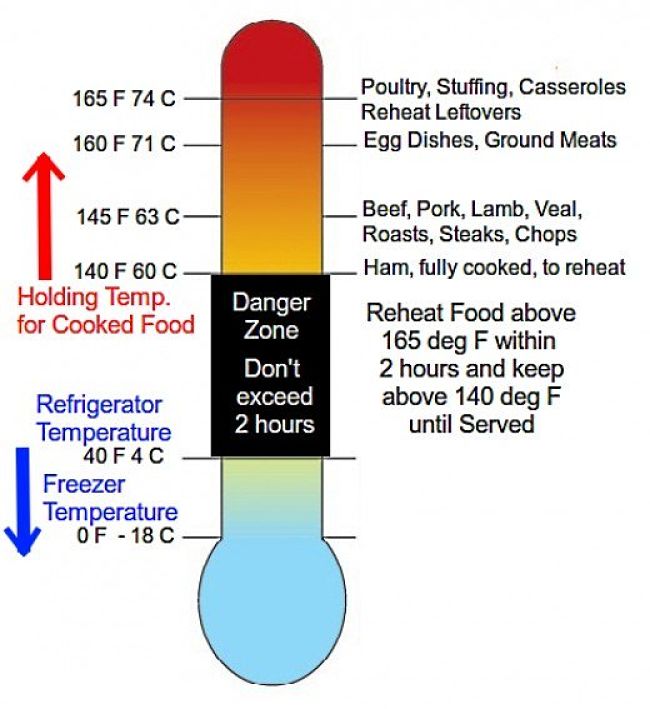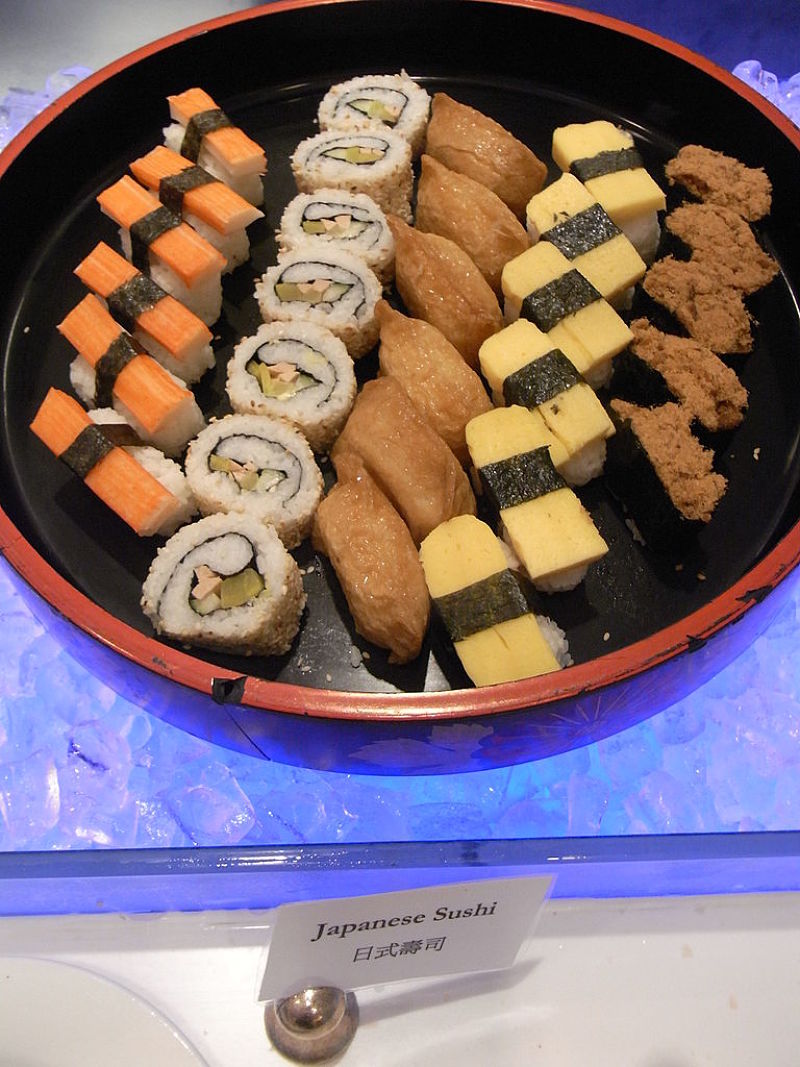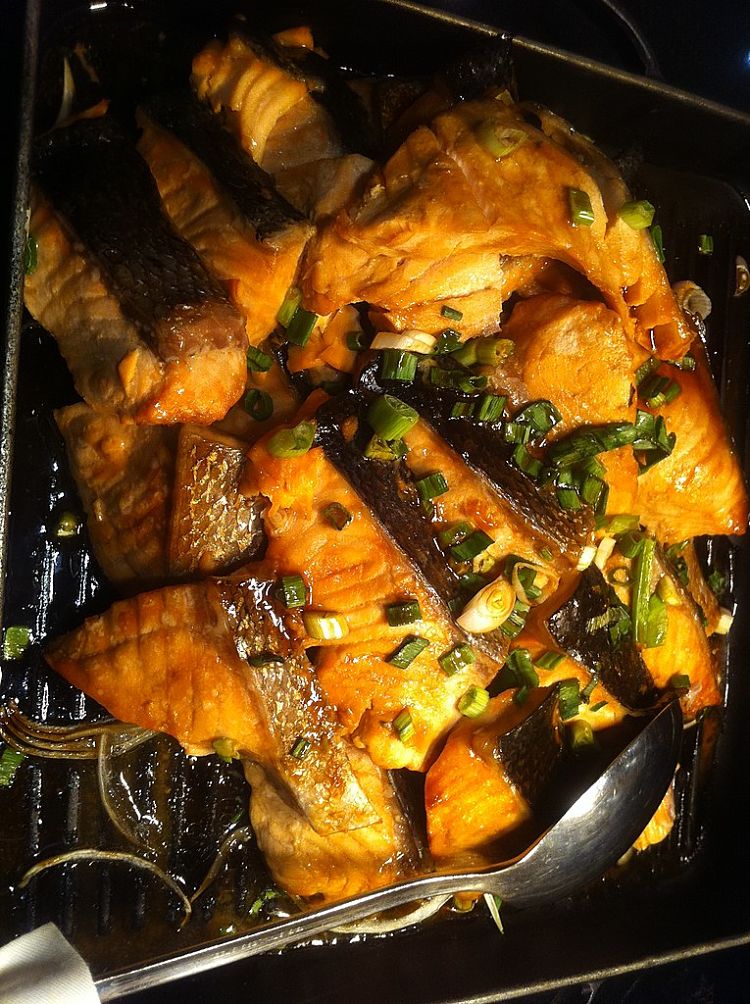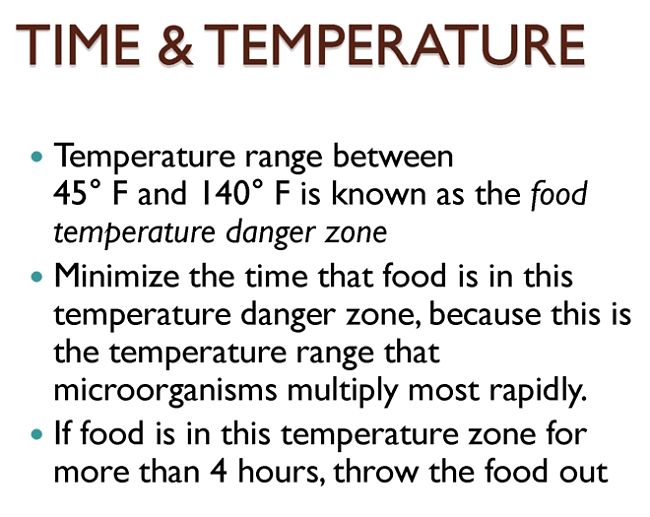Danger Zone Food Safety Temperature Charts Cook, Reheat, Chill, Freeze
There is a lot of information about food safety and how to prevent food contamination by bacteria and other germs that pose serious health risks. However, the various kinds of information about storing food, minimal internal temperatures for cooking foods, and guidelines and keeping food warm for serving and reheating, are not combined together in a single reference.
This article is designed to solve this problem in relation to safe temperatures.
► It covers temperature requirements for food safety from the 'cradle to grave', so to speak.
► It includes charts on maximum recommended storage times in the refrigerator and freezer for various types of food.
► It includes the minimum internal temperatures recommended for various foods when they are cooked to prevent contamination by germs.
► It also include the general guidelines for keeping food warm prior to serving, and for reheating foods. Having all this information together in the one article is useful and convenient.
► You should be aware which foods are the worst contamination risks and particularly the meats that cause most food poisoning problems. Extra precautions are needed for these foods.

The Food Temperate Danger Zone
As is shown in the image above, bacteria and other germs can proliferate and contaminate foods in temperatures between 40 degrees F (4 degrees C) and 140 degrees F (60 degrees C). This is known as the Food Danger Zone. Lower temperatures stops the germs from proliferating and higher temperatures kills them. So this zone is the go zone for contamination and potential food poisoning. Keeping foods in this danger zone for periods of an hour or more can mean that germs proliferate on the food and can make it harmful for health, perhaps leading to death from various infections.
Various foods should be cooked to the specified minimum internal temperatures to kill any germs present. Use a good quality food thermometer inserted right into the center of the thickest part of the food. Prepared foods such as curries should be stirred before checking, particularly when using frozen foods. The temperatures for various types of food are summarized in the image above. A detailed chart listing the safe internal temperatures for most common foods is provided at the end of the article.
How to Check the Minimum Safe Temperatures when Cooking Food
You can’t tell whether any meat or meat dish is safely cooked and free of bacteria and other harmful agents by simply looking at it, or prodding it. Thickness and rate of heating are important, as well as the way the food is handled or thawed before cooking. On the other hand, food does not need to be burnt to a crisp either. You need to use a good quality thermometer inserted into the center of the thickest part of the meat. The time the meat is held at the minimum safe temperature is also very important, not just the temperature itself. Temperature will generally continue to rise after the food is removed from the over, but you can’t predict or rely on this as it depends on how the food is cooked. Exceed the minimum temperature and time slightly, as an extra precaution. Allowing the food to rest for the specified time also helps ensure any harmful germs are destroyed because the temperature will continue to rise during this period before dropping
Properly cooked and uncured red meats such as pork or steak, can be served rare, with a pink color after the meat has reached the specified safe internal temperature for the required time.
Use the chart shown below and a food thermometer to ensure that poultry, meat, processed meats, seafood and various prepared meals reach a safe minimum internal temperature before serving.
Importance of Time at Recommended Safe Temperature
It is important that the food is held at the critical safe temperature long enough to kill the bacteria, fungus and other germs that can cause contamination. The chart below summarizes the recommended times for various foods.
Times Food Needs to be Kept of Specified Internal Temperature to Ensure its Safe
|
Food
|
Times at Recommended Internal Temperature
|
|---|---|
|
Beef roast (higher temperatures are preferred)
|
145 degrees F (63 degrees C) for minimum of 3 minutes
|
|
Beef roast
|
OR 140 degrees F (60 degrees C) for 12 minutes
|
|
Beef roast
|
OR 130 degrees F (54 degrees C) for 121 minutes
|
|
Beef, steaks, pork, ham, fish, seafood (filets, chops or intact pieces), bacon
|
145 degrees F (63 degrees C) for minimum of 15 seconds
|
|
Ground beef or pork, chopped/flaked meat
|
155 degrees F (68 degrees C) for minimum of 15 seconds
|
|
Poultry, stuffed foods
|
165 degrees F (74 degrees C) for minimum of 15 seconds
|
|
Eggs Cooked and kep warm for serving
|
155 degrees F (68 degrees C) for minimum of 15 seconds
|
|
Eggs Cooked to order
|
145 degrees F (63 degrees C) for minimum of 15 seconds
|
|
Foods Cooked in Microwave Oven
|
165 degrees F (74 degrees C) for minimum of 2 minutes
|
|
Fruits, vegetables
|
135 degrees F (57 degrees C) (no minimum time)
|
General Guidelines for Holding Cooking Foods
One of the major causes of food poisoning, apart from cross-contamination between raw risky meats such as poultry and ground beef, is keeping food warm for long periods. This creates the perfect set of conditions for the germs to multiply and contaminate the food. Various health authorities have issued strict rules about holding and handling cooked foods. See this reference for a good summary of the principles.
Some of the tips that apply in the home are:
- Cold foods should be kept at temperatures below 40 degrees F (4 degrees C) – refrigerator temperature.
- Hot food should be kept warm at temperatures above 135 degrees F (57 degrees C).
- Do not use hot holding equipment to heat or reheat food.
- Check temperature frequently (at least 30-60 minutes.
- Take actual measurements of the food temperature; do not rely on a thermostat setting.
- Store serving utensil in food, otherwise germs may grow in food remnants at room temperature.
- Stir the hot food regularly.
- Always keep food covered.
General Guidelines for Reheating Foods
There are strict regulations for commercial food suppliers about reheating of foods.
The general principle is that all leftover foods or pre-cooked foods or any leftover foods used as an ingredient be regarded as potentially contaminated and be reheated to at least 165 degrees F (74 degrees C) for least 15 seconds before being served.
This is a good principle to follow in the home as well as it destroys the bacteria that could cause food poisoning. It is essential that all parts of the food reach the minimum temperature for 15 seconds, and this will require thorough stirring and mixing.
General Guidelines for Food Storage Limits in the Refrigerator or Freezer
The table below summarizes the food storage limits for common refrigerated and frozen foods. Use labels attached to each item to enable the storage times to be checked. Always err on the safe side and follow the 'use by dates' and 'best before dates' on the packages.
Test Your Food Thermometer Regularly to Make Sure it is Accurate
A poorly calibrated food thermometer may be worse than none as you may ignore warming signs that the food is not cooked properly. Test regularly using the freezing and boiling point for water:
- Cold Test - Add crushed ice to a glass, add a little cold water and stir to cool the water down to freezing. Place your thermometer stem about 2 inches (5 cm) into the water without coming into contact with the glass. Leave for about 30 - 60 seconds. Check that thermometer reads 32 degrees Fahrenheit (0 degrees C).
- Hot Test - Boil some water in a saucepan. Remove from the stove and insert your thermometer about 2 inches (5 cm) into the water, and without touching the side or bottom. Swirl the thermometer around with your hand and after 30 -60 seconds, and check that the thermometer read 212 degrees Fahrenheit (100 degrees C).
If the readings are wrong you can re-calibrate many of the more expensive thermometers of replace them.
Safe Minimal Internal Temperatures for Cooking Various Types of Food
|
Min Internal Temperature Degrees C
|
Food
|
Min Internal Temperature degrees F
|
|---|---|---|
|
82
|
Whole Game birds/waterfowl (wild turkey, duck, goose, partridge and pheasant)
|
180
|
|
77
|
Well done, Beef, Veal and Lamb
|
170
|
|
74
|
Chicken & Turkey, whole
|
165
|
|
74
|
Poultry breasts, roasts
|
165
|
|
74
|
Poultry thighs, legs, wings
|
165
|
|
74
|
Duck & Goose
|
165
|
|
74
|
Stuffing (cooked alone or in bird)
|
165
|
|
74
|
Leftovers
|
165
|
|
74
|
Casseroles
|
165
|
|
74
|
Ground Poultry (chicken, turkey)
|
165
|
|
74
|
Pieces Poultry (chicken, turkey, duck)
|
165
|
|
74
|
Egg dishes
|
165
|
|
74
|
Shellfish (shrimp, lobster, crab, scallops, clams, mussels and oysters; discard any shellfish that do not open)
|
165
|
|
74
|
Hot Dogs
|
165
|
|
74
|
Stuffing
|
165
|
|
74
|
Leftovers
|
165
|
|
74
|
Game Chops, steaks and roasts (deer, elk, moose, caribou/reindeer, antelope and pronghorn) - Well cooked
|
165
|
|
74
|
Ground Game meat and meat prducts
|
165
|
|
74
|
Ground Venison and sausage
|
165
|
|
74
|
Breasts and roasts of Game birds/waterfowl (wild turkey, duck, goose, partridge and pheasant)
|
165
|
|
74
|
Thighs, wings of Game birds/waterfowl (wild turkey, duck, goose, partridge and pheasant)
|
165
|
|
74
|
Poultry Stuffing (cooked alone or in bird)
|
165
|
|
71
|
Beef, Pork, Veal, Lamb
|
160
|
|
71
|
Eggs
|
160
|
|
71
|
Egg dishes
|
160
|
|
71
|
Medium Cooked, Beef, Veal and Lamb
|
160
|
|
71
|
Pork (pieces and whole cuts)
|
160
|
|
71
|
Ground Beef, Veal (including mechanically tenderized), Lamb and Pork
|
160
|
|
70
|
Fish
|
158
|
|
63
|
Fin Fish
|
145
|
|
63
|
Shrimp, lobster, and crabs
|
145
|
|
63
|
Clams, oysters, and mussels
|
145
|
|
63
|
Scallops
|
145
|
Safe Maximum Storage Times for Various Foods in the Refrigerator and Freezer
|
Food
|
Max Storage Times in Refrigerator at 4 degrees C / 40 degrees F
|
Max Storage Times in Freezer at Minus 18 degrees C / zero degrees F
|
|---|---|---|
|
Steaks - Fresh beef, veal, lamb, and pork
|
3-4 days
|
6-12 months
|
|
Chops - Fresh beef, veal, lamb, and pork
|
3-4 days
|
4-6 months
|
|
Roasts - Fresh beef, veal, lamb, and pork
|
3-5 days
|
4-12 months
|
|
Offal and Variety meats: tongue, liver, heart, and kidneys
|
1-2 days
|
3-4 months
|
|
Ham - cooked whole ham
|
7 days
|
1-2 months
|
|
Ham - cooked half ham
|
6-7 days
|
1-2 months
|
|
Ham - cooked slices
|
3-4 days
|
1-2 months
|
|
Pieces - Chicken and Turkey
|
1-2 days
|
6-9 months
|
|
Poultry Giblets
|
1-2 days
|
3-4 months
|
|
Hot dogs within use by date - opened package
|
1 week
|
2 weeks
|
|
Hot dogs within use by date - unopened package
|
2-3 months
|
2-3 months
|
|
Luncheon Meats within use by date - opened package
|
3- 5 days
|
1- 2 months
|
|
Luncheon Meats within use by date - unopened package
|
2 weeks
|
1- 2 months
|
|
Bacon
|
7 days
|
1 month
|
|
Raw sausage within use by date (chicken, turkey, pork and beef)
|
1-2 days
|
2-3 months
|
|
Eggs fresh raw
|
Use by 'Best Before' date
|
4 months (blended eggs)
|
|
Eggs fresh yolk and white
|
2 - 4 days
|
4 months
|
|
Eggs - hard cooked eggs
|
1 week
|
Not recommended
|
|
Small Game Rabbits and Squirrel
|
1-2 days
|
6-12 month
|
|
Large Game Venison etc.
|
2-4 days
|
6-12 months
|
|
Ground meat from Game
|
1-2 days
|
2-3 months
|
|
Game Stew or Casseroles
|
3-4 days
|
2-3 months
|
|
Raw Wild Birds (ducks, goose, pheasant)
|
1-2 days
|
3-6 months
|
|
Cooked Duck or Goose
|
3-4 days
|
2-3 months
|
|
Raw Giblets
|
1-2 days
|
3-4 months
|
|
Cooked fish
|
1-2 days
|
4-6 months
|
|
Fatty fish: mullet, ocean and sea perch, char, sea trout, striped bass, salmon, mackerel, bluefish and tuna
|
2-3 days
|
2-3 month
|
|
Pollock, ocean perch and sea trout
|
2-3 days
|
4 months
|
|
Fresh lean fish: cod, flounder, haddock, halibut and perch
|
2-3 days
|
3-6 months
|
|
Herring
|
3-4 days
|
2 months
|
|
Cold-smoked salmon and white fish
|
5-8 days
|
2 months
|
|
Hot-smoked salmon and white fish
|
14 days
|
6 months
|
|
Other smoked fish
|
1-2 weeks
|
4-5 weeks
|
|
Opened Canned fish
|
1 day
|
Not recommended
|
|
Cooked Shellfish
|
1-2 days
|
6-12 months
|
|
LobsterTails
|
1-2 days
|
6 months
|
|
Labster Raw
|
1-2 days
|
6-12 months
|
|
Shrimp Cooked
|
3-4 days
|
3 months
|
|
Crab Cooked
|
3-5 days
|
2 months
|
|
Clams and mussels De-shelled (shucked)
|
1-2 days
|
3-4 months
|
|
Scollops De-shelled (shucked)
|
1-2 days
|
3-4 months
|
|
Live Oysters De-shelled (shucked)
|
1-2 days
|
3-4 months
|
|
Opened Canned Shellfish
|
1 day
|
Not recommended
|
|
Leftovers and prepared foods - meat and casseroles
|
3-4 days
|
2-3 months
|
|
Leftovers and prepared foods - gravy and meat broth
|
3-4 days
|
2-3 months
|
|
Leftovers and prepared foods - fried chicken
|
3-4 days
|
4 months
|
|
Leftovers and prepared foods - poultry casseroles
|
3-4 days
|
4-6 months
|
|
Leftovers and prepared foods - plain poultry pieces
|
3-4 days
|
4 months
|
|
Leftovers and prepared foods - Meat and poultry pieces covered with broth or gravy
|
3-4 days
|
6 months
|
|
Macaroni salad and Tuna salad
|
3-5 days
|
Not recommended - does not freeze well
|
|
Cooked Stuffing
|
3-4 days
|
1 month
|
|
Soups and stews (with meat or vegetables)
|
3-4 days
|
2-3 months
|




